Claudia and I have been busy since our trip to Colorado in early October, so I haven’t had a chance to post more images from our travels until now. But maybe that’s a good thing, as that time has given me a chance to reflect on the journey.
It had been a dream of mine to photograph the autumn aspen display in Colorado, and it more than lived up to my expectations. Colorado veterans said it was the best fall there in many years, and it certainly looked good to us. The sheer number of aspens covering the hillsides was astonishing.
The problem was that I didn’t know the area. At all. I’m usually writing about photographing Yosemite, or maybe the aspens on the eastern side of the Sierra, places that I know intimately. That knowledge is a big advantage, giving me a greater chance of being in the right place at the right time to take advantage of the light, weather, and conditions.
Although I’d been to Colorado before, my previous visits had been brief, in different seasons, and not focused on photography. So I was almost starting at the beginning. Since we only had a week, I viewed this as a scouting trip, but of course I hoped to make some good photographs while I was there.
I didn’t have time to do much research, but I wasn’t groping around blindly. A workshop student told me about Jason Hatfield’s ebook Colorado Fall Colors: A Photographer’s Guide, which I found quite helpful. We also followed reports online about current conditions.
Best of all, we got an invitation from our friends Jennifer Yu and her husband Jeremy to visit them in Crested Butte. Jen writes the popular food blog userealbutter. In addition to being a fantastic food photographer, she’s also an excellent landscape photographer, and after serving us an amazing dinner she and Jeremy gave us detailed notes about some of their favorite locations for aspens.
So armed with this knowledge, Claudia and I set forth into the Colorado mountains. First we explored areas north and west of Crested Butte like Kebler Pass and McClure Pass. Then we drove down to the San Juan Mountains and photographed near Ridgway and Telluride.
Even though I didn’t know the area well, many years of photography had taught me what to look for. I think that this is, ultimately, more valuable than the best guidebook. This ability to recognize opportunities comes from long experience photographing many different combinations of subject, light, and weather, knowing what worked and what didn’t, and then anticipating when certain elements might come together again.
Every time you venture out into the world with your camera, you’re accumulating some of that experience, and the knowledge gained will help you in the future. You’re also learning what you like, photographically – what speaks to you, and what doesn’t – which will help you to make more personal photographs that express your own unique perspective.
While there’s no substitute for that first-hand, in-the-field experience, I thought it might be helpful to explain my thought process in making some of these Colorado aspen photographs – what I was looking for, and why. Of course each person will be attracted to different subjects and scenes, but I still hope you might learn something from seeing how I approached photographing an unfamiliar area.
Jason Hatfield uses a lot of wide-angle lenses in his photography, and his ebook includes many beautiful, sweeping views of aspens with mountains in the background. While I would have loved to photograph some classic Colorado scenes like this, I knew that would require some luck with weather and clouds, and the forecasts weren’t promising. Without clouds, my best bet for making interesting, evocative images was to focus on more intimate scenes. I was especially looking for aspens stands with big, tall, white trunks, lakes or ponds lined with aspens, and interesting small-scale lighting events.
Our friend Jen mentioned a trail near Crested Butte with lots of “tall, straight, aspen trunks.” That caught my attention, since that was one of the specific things I was looking for. So we made it a point to go there, and it was one of the most beautiful aspen groves I’ve seen.
It was a sunny, clear afternoon, so I looked toward the sun, since backlight almost always works best for sunlit forest scenes, especially with something translucent and colorful like aspen leaves. I walked around looking for clean, harmonious, balanced arrangements of trunks, and repeating patterns. I tried many compositions, but in this case used a wide-angle lens to include some of the treetops, and put the sun in the frame to give the image a focal point, and add a bit of sunny-day mood. (1/20th sec. at f/11, ISO 100, 24mm)
After making the previous photograph (and a few others in the same vicinity), I packed up my camera and started walking back to the car when I noticed how the yellow tops of these aspens were catching the sun, while the trunks below were in the shade. It was quite striking – definitely one of those small-scale lighting events I was looking for. I put on my 24mm lens, looked up, and tried various arrangements before settling on this composition. I wanted to balance the trunks, and luckily found an arrangement where the three most prominent trunks on the left side of the frame roughly mirror the three most prominent trunks on the right side. I also loved the pattern created by the yellow clumps of leaves at the tops of the trees. (1/30th sec. at f/16, ISO 80, 24mm)
It was a sentence from Jason Hatfield’s ebook that lead me to this spot near McClure Pass. He called the stands in this area “some of the best I’ve found for intimate compositions.” Right up my alley! Sometimes casual phrases like this in a guidebook – even a trail guide, or tourist guide – have led me to some great locations.
When we first found this spot it was in the sun, but that contrasty, splotchy light wouldn’t work at all for this scene, so we made a point of coming back later in the afternoon when it was in the shade. I liked the tall white trunks, of course, but also the bands of color above and below the trunks. In a good situation like this I try to leave no compositional stone unturned, so I tried a variety of compositions here, but liked this one the best. Again, it’s balanced, both top-to-bottom and left-to-right. (1/10th sec. at f/16, ISO 400, 75mm)
Later the same afternoon I made the first two images shown in this earlier post. For the second one, “Late-afternoon sunlight in an aspen forest,” I noticed the light when driving by at 40 miles per hour, made Claudia stop, ran back to this spot, and captured a couple of frames before the light faded. I’ll keep this location in mind if I ever go back, and also look for places where similar lighting might occur.
After the sun went down we noticed a small dirt road nearby and decided to explore it, which is when I found the composition shown in the first image of that other post. The soft, dusky light worked perfectly for that scene.
I wanted to photograph aspens next to a lake or pond, but this was surprisingly hard to find in Colorado. However, I remembered seeing a workshop student’s photograph of an aspen-lined lake, and was able to get directions to this “secret” spot from him.
I later found other images of this lake online. All these photographs were wide-angle views, more like the image I included in my first Colorado post. But it also seemed possible to zoom in and make some more abstract compositions of the aspens and their reflections. It seemed like a spot with tremendous potential.
Reaching this location required a long drive on a bumpy dirt road, culminating in a rocky four-wheel-drive section. But it was worth it. As beautiful late-afternoon light slanted across the scene I switched back and forth between wide-angle and telephoto lenses, trying again to leave no compositional stone unturned. These images are probably my two favorites, though it was hard to choose. (First image: 1/15th sec. at f/11, ISO 50, 89mm, polarizing filter; second image: 1/8th sec. at f/11, ISO 50, 89mm, polarizing filter)
Jen and Jeremy described this general area to us (it’s near Telluride), but from there we were led by our eyes. It was actually a very obvious spot, easily visible from a major highway, and striking because of all the orange and red leaves. Luckily a dirt road passed right through this grove, making it easily accessible.
When we arrived at this location the sun was going in and out of clouds. I liked the shade much better, with soft backlight making the leaves glow. I climbed up a steep slope looking, as always, for patterns, and a clean arrangement of trunks, and found this view with all the trunks curving to the right. Then I just had to wait for the sun to go behind a cloud. (1/30th sec. at f/16, ISO 50, 50mm)
We did finally get some weather, on our second-to-last day in Colorado, with off-and-on showers, clouds, and high-elevation fog. Conditions weren’t right for grand landscapes because the peaks were hidden in the clouds. We tried to get up into the fog, but it proved to be elusive. So we drove around and explored the area, and found many beautiful scenes with clouds and mist drifting across aspen-covered hillsides. This photograph near Telluride is one of my favorites from the day, with interesting multiple patterns and a nicely-arranged veil of mist. (1/2 sec., at f/11, ISO 50, 160mm)
This is perhaps my favorite photograph from the trip, made on our last morning in Colorado. The rain had stopped, but elevations above 8,000 feet were socked in with fog. I was psyched, as I really wanted to photograph aspens in the fog, especially after looking at this wonderful image by Charlie Cramer every day for the past eight years (it’s hanging on our wall).
At this point we had been in the Ridgway/Telluride area for a few days, which was a big advantage because we had some sense of where the best locations were, and what scenes might work in the fog. We started at the Dallas Divide, a well-known spot near Ridgway. Then we decided to go to this area along a nearby dirt road. We had driven this road before, and knew we would find some colorful red and orange aspens there, which we hoped it would be in the fog – and luckily they were.
I noticed this beautiful juxtaposition of foreground and background aspens right away, but couldn’t see a composition at first, so decided to try another spot just up the road. But I was drawn back to this view, and soon found a composition I liked, and another, and another. This is my favorite, though it was a difficult choice. I loved the foggy atmosphere, the color, the multiple patterns, and the sense of depth in a smaller-scale landscape. (1/15 sec. at f/16, ISO 200, 50mm; three images blended together to get sufficient depth of field.)
After making the image at the top of this post, we were driving away when I noticed this group of trees through the fog. There’s almost no sense of depth here, but I liked the ethereal, low-contrast, yet colorful look of this scene. (1/4 sec. at f/11, 100 ISO, 189mm)
When you don’t know an area well, sometimes you just get lucky and find yourself in the right place at the right time.
This photograph was also made on our last morning. The fog had lifted slightly, so we headed up another nearby dirt road, one we’d never driven before, that led to higher elevations. We eventually got back into the fog, and found some nice misty aspen scenes. Then we continued up the road, and noticed that the fog was starting to break, revealing glimpses of peaks above. We turned a corner and came to this spot just as patches of blue sky appeared and Mt. Sneffels came into view. I couldn’t have asked for a better location, with the V-shaped valley of aspens framing the triangular peaks above. Wandering up a dirt road in the fog we had stumbled into the right spot at the right time; just pure, absolute luck. Maybe we should have bought a lottery ticket that day! We saw three other photographers nearby who apparently knew this location and had waited for the fog to clear. Within minutes the peaks disappeared behind the clouds again, and stayed hidden until sunset. (1/60 sec. at f/13, ISO 100, 89mm)
The light and clouds that last day were so interesting we just couldn’t leave! We went to this spot early in the afternoon because I thought it would work with this beautiful, dappled, chiaroscuro light. Again, it helped to know the area, even a little bit, since we’d been around for a few days. It often takes some patience to wait for the light to hit the right spots with this kind of dappled light. I wanted the light to draw the viewer’s eyes to the color in the center, not toward the edges of the frame. (1/10 sec. at f/11, 50 ISO, 85mm)
We loved our visit to Colorado, and are already planning to go back next fall. We’ll have a better idea of where to go next time, but I also have a long list of new places that I’d like to explore. Can’t wait!
— Michael Frye
Related Post: Aspen Pilgrimage
Did you like this article? Click here to subscribe to this blog and get every new post delivered right to your inbox!
Michael Frye is a professional photographer specializing in landscapes and nature. He is the author or principal photographer of The Photographer’s Guide to Yosemite, Yosemite Meditations, Yosemite Meditations for Women, Yosemite Meditations for Adventurers, and Digital Landscape Photography: In the Footsteps of Ansel Adams and the Great Masters. He has also written three eBooks: Light & Land: Landscapes in the Digital Darkroom, Exposure for Outdoor Photography, and Landscapes in Lightroom 5: The Essential Step-by-Step Guide. Michael has written numerous magazine articles on the art and technique of photography, and his images have been published in over thirty countries around the world. Michael has lived either in or near Yosemite National Park since 1983, currently residing just outside the park in Mariposa, California.

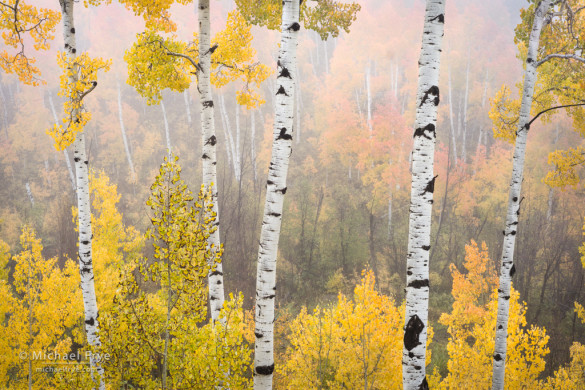
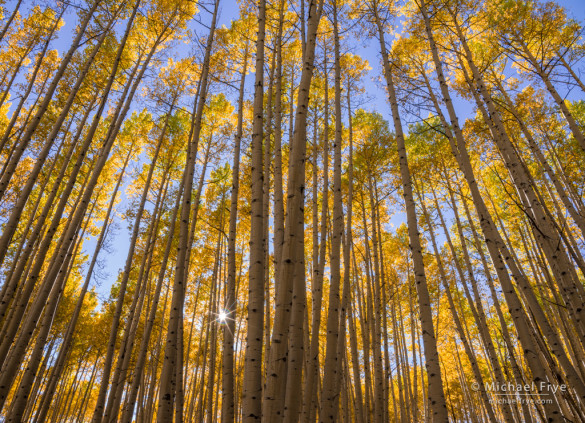
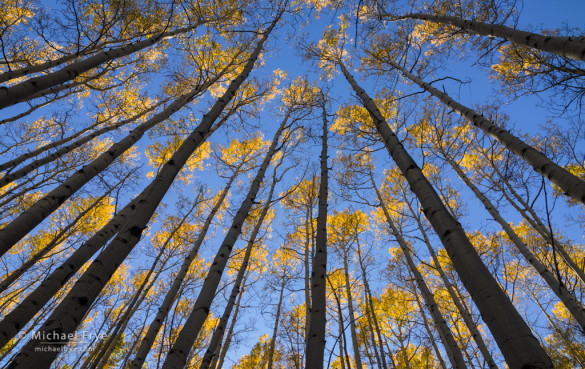
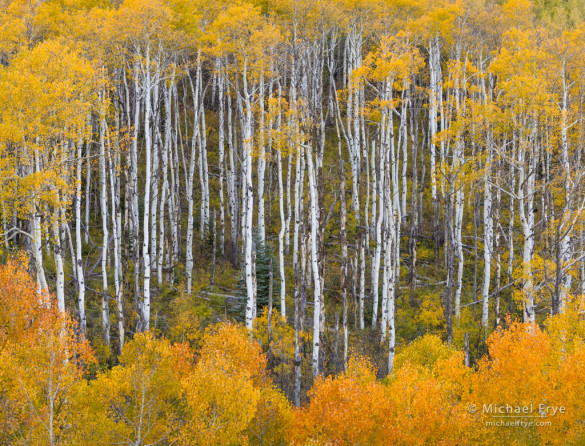
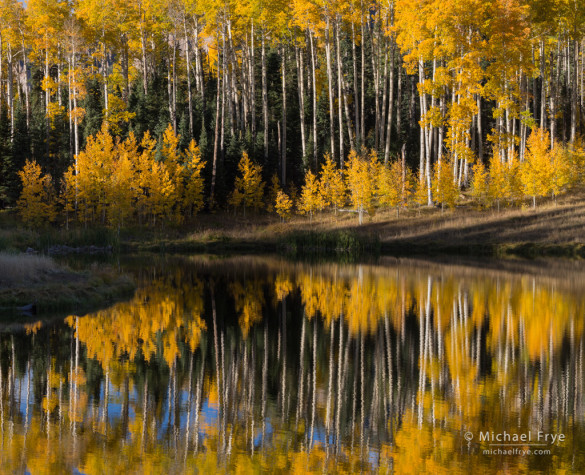
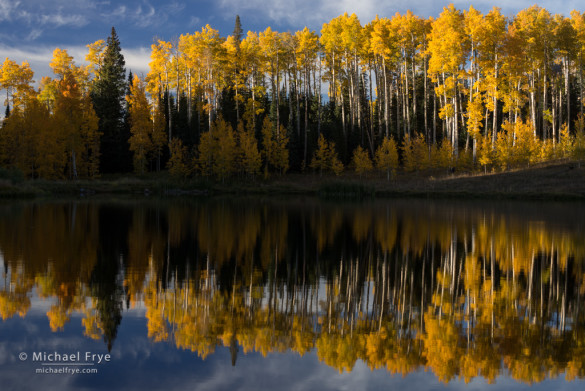
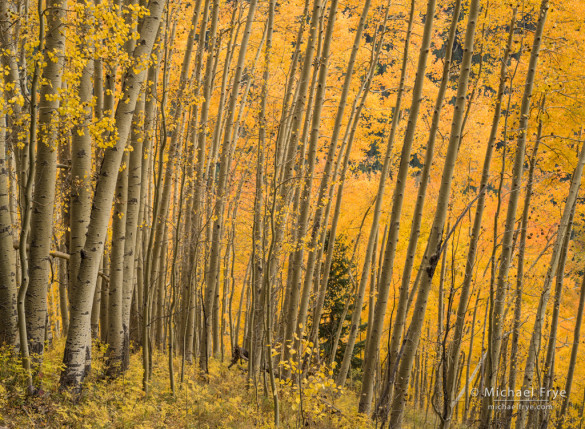
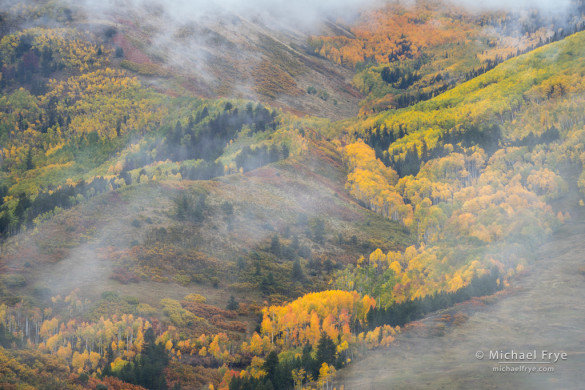
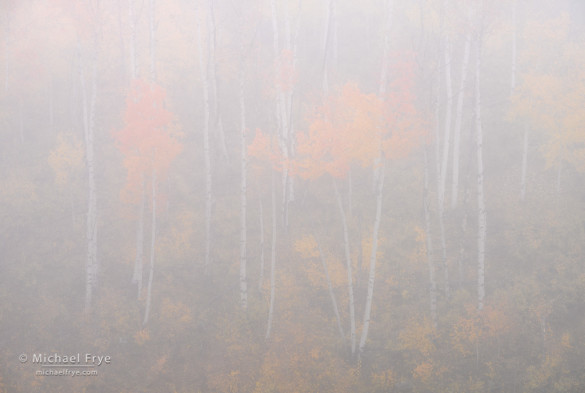
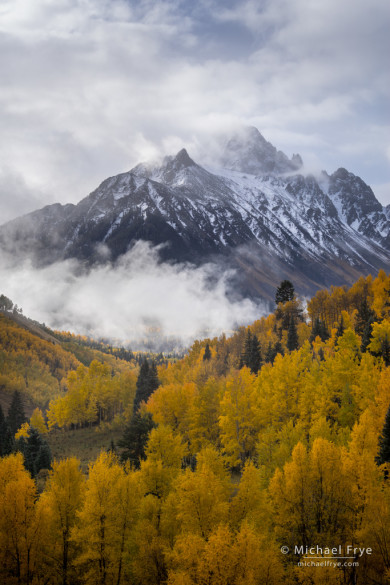
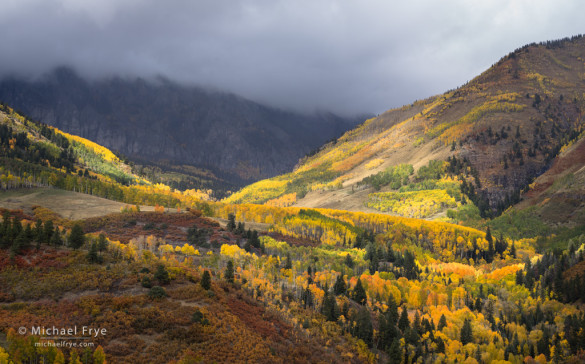








Wonderful images as usual, Michael!
My favorite is:
“Ethereal aspens near Ridgeway, CO”
Thanks very much Bill! I like that one too; I think we both like abstract, minimalist images. We got really lucky with the fog.
Yes, I have a strong tendency towards the minimalist image, but also love to take on complex, “Rubrik’s Cube” compositional puzzles we often find in the landscape!
I like that description. I never thought of it as a Rubrick’s Cube, but there are some parallels. I also like rich, complex photographs that don’t cross the line into being busy and confusing.
Michael, they are all quite stunning. My favorite is “Aspen reflections, Uncompahgre NF, CO”.
I find it very helpful/educational when you explain your thought process as you did here. Thanks very much for continuing to share your wealth of knowledge.
You’re welcome John, and thank you!
I couldn’t wait to see the bevy of great photographs from your first CO fall trip. I knew you would be addicted and love the ebook. These are all great photos but my favorites are Aspens in the fog and Aspen Reflections of course! Thanks for sharing your thought processes!
Thanks Karl! And thanks for your help!
Michael,
All of these images captured the essence of a Colorado autumn. You even caught a dusting of snow on Mt. Sneffels which I always feel adds to the Colorado experience. Intimate landscapes are more interesting to me than grandscapes and I am glad you chose to concentrate on that theme during your trip.
Indeed, this year was one of the best falls for aspen photography here in Colorado in about a decade.
Also, your text pointed out that one of the more valuable pieces of photographic equipment one can have is a good off road vehicle!
Thanks James! Yes, there are a lot of dirt roads, and four-wheel-drive helps. Although we could’ve walked that last stretch to that one spot – it was less than a mile. 🙂
Very inspirational photos of beautiful fall colors…
Fall colors and fog…just perfect!!
Thank you Michael,
Thanks so much Don!
Michael,
Loved this post. I’ve been to Colorado several times, but not in the autumn. Now that I am retired from teaching, I can now do the research and go. Thanks for the motivation. By you sharing your experiences on your blog, you have given me many ideas. For example, I appreciated the info about the waterfalls along the Blue Ridge Parkway, particularly Eastatoe Falls.
Oh, of the two lake/aspen photos, I think I like the one closer. I’m drawn to the highlighted grasses, but they are both nice.
Thanks Alan, and I hope you do get a chance to go to Colorado in the fall – it’s great.
Fascinating discussion, Michael. Appreciated your sharing your thought processes. And the images… simply superb!
Thanks very much Larry!
Nice images! I noticed several of your shots taken at ISO 50 and was wondering why? I was under the impression that the best quality ISO setting would be the camera’s native ISO, which if you were using your Canon would be 100. I have always understood that ISO 50 would not provide any better quality but is an option to use if you are looking for longer shutter speeds. Is my understand out dated?
Thanks Greg! In some cases I used 50 ISO to lower the shutter speed and avoid the shutter-shake issue with my Sony A7r. In other cases I probably just forgot to change it back to 100 ISO when I changed lenses. Yes, supposedly image quality is best at the native ISO. On the other hand, dxomark’s sensor tests consistently show better dynamic range and lower noise at 50 ISO than at 100 ISO with every sensor, though the differences are small.
Thanks for sharing your beautiful images and travel notes from your trip to Colorado this fall. As you noted, the Aspen groves are amazing around the San Juan mountains.
Very inspiring, perhaps we can hope for a workshop lead by you in this area in the future?
You’re welcome Richard, and thanks! As for a workshop… maybe. 🙂
My sister, friend and I drove from Denver to Leadville, over Independence Pass into Aspen. Maroon Bells was absolutely gorgeous this year. This was around Sept 22nd. We went to Telluride and over to Gunnison. What a fabulouse drive. You picked a great year to photograph this beautiful state. Even my Ipad captured the beauty. I really enjoy seeing your beautful photos on Facebook. We live in a remarkable county and you capture it.
Sandra, I’m glad you were able to get out and see the fall color. It does sound like it was a good year, though I don’t have any personal experience to go by. Thanks for the kind words.
Looks like you had a great fall color trip to Colorado and captured a lot excellent new images. I especially love the two aspen in the fog images. I know what you mean about Charlie’s aspens in the fog print as I bought a copy too a few years ago and very much hope to get to photograph aspens in fog in Utah or Colorado sometime soon! We don’t get that chance in our high Eastern Sierras. Thanks again for sharing all these gorgeous images.
Thanks Wayne. I’m glad you have a print of Charlie’s photo – it’s a great image. I wouldn’t say fog is out of the question among eastern Sierra aspens, but it’s certainly uncommon in October, and probably more common in Colorado or Utah during the fall color season.
Beautiful images Michael, I’m glad you made it out to Colorado and found my eBook helpful (I know I’ve found your app helpful in Yosemite)! I wasn’t sure where the uptick in eBooks sales was coming so late in the season so thank you! I really love your intimate shots and I’m glad you got to be here during one of our best fall shows!
Thanks Jason. We had a great time in Colorado, and your ebook was a big help! Many people have told us it was an exceptionally good fall in Colorado, so I guess I can never go back, since it probably won’t be that good again. 🙂
Well if you do come back, let me know!
Michael, looking through old email and came across the one about Aspens in CO. Am heading out early tomorrow up near Cottonwood Pass CO and hope to get some god photos. Thanks for the great info, hope it works for me!
You’re welcome Sean, and good luck!